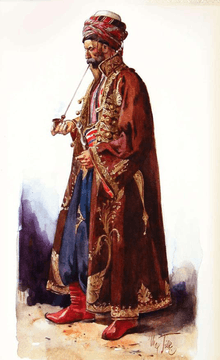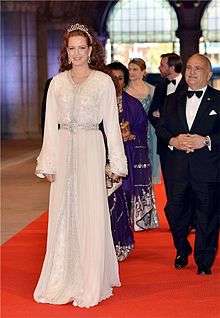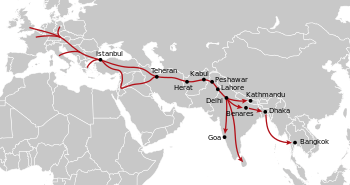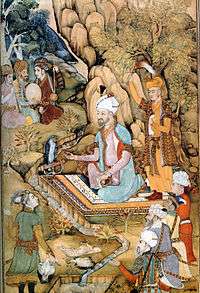Kaftan

A kaftan or caftan (Arabic: قفطان qafṭān) is a variant of the robe or tunic, versions of which have been worn by several cultures around the world for thousands of years. The kaftan is often worn as a coat or overdress, usually reaching to the ankles, with long sleeves. It can be made of wool, cashmere, silk, or cotton, and may be worn with a sash. The caftan is of ancient Mesopotamian origin, and was worn by many middle-eastern ethnic groups.
Through its dissemination and evolution, the kaftan has acquired different styles, purposes, and names depending on the culture. In many regions with a warm climate, the kaftan is worn as a light-weight, loose-fitting garment. The kaftan has served as a symbol of royalty in some cultures
Ottoman kaftan

Kaftans were worn by the Ottoman sultans in the Ottoman Empire. The decorations, including the colours, patterns, ribbons, and buttons, indicated the rank of the person to whom they were presented. From the 14th century through 17th century, textiles with large patterns were used. The decorative patterns on the fabrics became both smaller and brighter in the late 16th and in the 17th centuries. By the second half of the 17th century, the most precious fabrics were those with 'yollu': vertical stripes with various embroideries and small patterns, the so-called "Selimiye" fabrics.
Most fabrics manufactured in Turkey were made in Istanbul and Bursa, but some textiles came from as far away as Venice, Genoa, Persia (Iran), India and even China. Kaftans were made from velvet, aba, bürümcük (a type of crepe with a silk warp and cotton weft), canfes, çatma (a heavy silk brocade), gezi, diba (Persian دیبا), hatayi, kutnu, kemha, seraser (Persian سراسر) (brocade fabric with silk warp and gold or silver metallic thread weft),[1] serenk, zerbaft (Persian زربافت), tafta (Persian تافته). Favoured colours were indigo blue, kermes red, violet, pişmis ayva or "cooked quince", and weld yellow.
The Topkapi Palace Museum in Istanbul possesses a large collection of Ottoman kaftans and textiles.[2]
Maghrebi (North African) kaftan

In the Maghreb, kaftans are worn by women. The word kaftan in the Maghreb is commonly used for one piece dress. However, there are typical versions of maghrebi kaftans called Takchita (2 piece-dress and a large belt),etc. Kaftans can be worn on both casual and extremely formal occasions, depending on the materials used.[3]
This dress actually was masculine in the beginning which has become a dress worn by women during the centuries. Today, kafta is only used the describe women dress and people would rather describe the man's dress as Djellaba.
The Maghrebi kaftan is a result of the spreading of Middle-Easterners to North-Africa, which introduced the dress around the 6th and 7th centuries. In Algeria, Kaftan has been the main dress for the nobles and weddings for many centuries. It comes with different designs, most notably the Fergani Caftan from the Constantine region. Kaftans have been made by many Moroccan dynasties over the centuries including the Almoravids dynasty..
More recently, many Moroccan fashion designers has succeeded in promoting internationally the Moroccan Kaftan. A Moroccan fashion haut-couture show is once held in the year in Marrakech.[4] and several Moroccan magazines help promote the latest fashions like Femmes du Maroc, Citadine or Nissaa Min Al Maghrib
West African kaftan
In West Africa, a kaftan is a pullover robe. Kaftans are worn by both men and women. In West Africa, the female robe is called a kaftan, and the male robe is called the Senegalese kaftan.
A Senegalese kaftan is a pullover men's robe with long bell sleeves. In the Wolof language, this robe is called a mbubb and in French it is called a boubou. The Senegalese kaftan is an ankle length garment. It is worn with matching drawstring pants called tubay. Normally made of cotton brocade, lace, or synthetic fabrics, these robes are common throughout West Africa. A kaftan and matching pants is called a kaftan suit. The kaftan suit is worn with a kufi cap.[5] Senegalese kaftans are formal wear in all West African countries.
Other regional variations

Persian
Persian robes of honor were commonly known as khalat or kelat.[6]
Jewish
Due to historical and cultural links, some Jewish communities have a clothing style similar to other Eastern cultures when it comes to special occasions .The Chassidic Jews adopted a silky robe (Bekishe) or a frock coat (kapoteh) from the garb of Slavic nobility. The term kapoteh may originate from the Spanish capote or possibly from "kaftan", via Ladino. Sephardic Jews from Muslim countries wore a kaftan like their neighbours. The term "Kapote" is also used in Morocco.
Russian
In Russia the word "kaftan" is used for another type of clothing: a kind of a man's long suit with tight sleeves. The word "kaftan" entered was adopted from the Tatar language, which in turn had borrowed the word from Turkish.[7] By the 19th century, Russian kaftans were the most widely spread type of outer clothing among peasants and merchants. Currently they are used as a ritual religious clothing by the most conservative sect of Old Believers.
Kaftan in Western countries

The kaftan was reintroduced to the West in Russia in the 1890s when Alix of Hesse wore the traditional Russian kaftan during her coronation.[8] This traditional kaftan resembled the ones worn by Ottoman sultans and contrasted from the tight-fitting dresses with corsets common in England at that time.
The kaftan slowly gained popularity for its exoticism and as a form of looser-fitting clothing. French fashion designer Paul Poiret further popularized this style in the early 20th century.
In the 1950s, fashion designers such as Christian Dior and Balenciaga adopted the kaftan as a loose evening gown or robe in their collections.[9] These variations were usually sashless.
American hippie fashions of the late 1960s and the 1970s often drew from ethnic styles, including kaftans. These styles were brought to the United States from people who journeyed the so-called "hippie trail".[9] African-styled, kaftan-like dashikis were popular, especially among African-Americans. Street styles were appropriated by fashion designers, who marketed lavish, Moroccan-style kaftans as hostess gowns for casual at-home entertaining.
Diana Vreeland, Babe Paley, and Barbara Hutton all helped popularize the caftan into mainstream western fashion.[10] Into the 1970s, Elizabeth Taylor often wore kaftans designed by Thea Porter. In 1975 during her second wedding to Richard Burton, she wore a caftan designed by Gina Fratini.[11]
More recently, Jessica Simpson was often photographed wearing kaftans during her pregnancy in 2011.[8] American fashion editor André Leon Talley has also worn kaftans designed by Ralph Rucci as one of his signature looks.[12] Beyoncé, Uma Thurman, Susan Sarandon, Kate Moss, Mary-Kate and Ashley Olsen, and Nicole Richie have all been spotted in caftans.[13] Some brands like Willian by Keia Bounds have dedicated their 2015 Summer collections to kaftans[14]
Gallery
 The first Mughal Emperor Babur dressed in a kaftan.
The first Mughal Emperor Babur dressed in a kaftan. Evreu cu caftan (Jew in kaftan) by Nicolae Grigorescu
Evreu cu caftan (Jew in kaftan) by Nicolae Grigorescu Moroccan "Qaftan" or "Takshita"
Moroccan "Qaftan" or "Takshita" Portrait of the artist’s wife, Marie Fargues, in a kaftan, by Jean-Etienne Liotard
Portrait of the artist’s wife, Marie Fargues, in a kaftan, by Jean-Etienne Liotard.jpg) 21st century woman wearing kaftan, Spain
21st century woman wearing kaftan, Spain
See also
References
- ↑ "Sadberk Hanim Museum". Sadberkhanimmuzesi.org.tr. Retrieved 2013-09-29.
- ↑ IstanbulNet @ www.istanbulnet.com.tr. "Topkapi Museum: collection of Turkish textiles and kaftans". Exploreturkey.com. Retrieved 2009-10-09.
- ↑ http://www.morocco-guide.com/culture/traditional-clothing/
- ↑ http://www.moroccoworldnews.com/2015/04/156000/nicolas-cage-attends-caftan-show-2015-marrakech/
- ↑ Cicero, Providence (2009-02-27). "Afrikando Afrikando Dishes up Great Food with a Side of Quirkiness". The Seattle Times.
- ↑ "CLOTHING xxvii. lexicon of Persian clothing – Encyclopaedia Iranica". Iranicaonline.org. Retrieved 2013-09-29.
- ↑ Richard Hellie (15 June 1999). The Economy and Material Culture of Russia, 1600-1725. University of Chicago Press. p. 354. ISBN 978-0-226-32649-8.
- 1 2 Hix, Lisa (17 July 2014). "Caftan Liberation: How an Ancient Fashion Set Modern Women Free". Collectors Weekly. Retrieved 16 January 2015.
- 1 2 Annette Lynch; Mitchell D. Strauss (30 October 2014). Ethnic Dress in the United States: A Cultural Encyclopedia. Rowman & Littlefield Publishers. pp. 61–62. ISBN 978-0-7591-2150-8.
- ↑ Erika Stalder (1 May 2008). Fashion 101: A Crash Course in Clothing. Houghton Mifflin Harcourt. p. 13. ISBN 0-547-94693-7.
- ↑ Salamone, Gina (2 December 2011). "Elizabeth Taylor's prized possessions - ranging from diamonds to designer gowns - on view at Christie's before going on auction". NY Daily News. Retrieved 16 January 2015.
- ↑ Smith, Ray A. (9 October 2013). "An Emperor of Fashion". The Wall Street Journal. Retrieved 16 January 2015.
- ↑ http://www.collectorsweekly.com/articles/caftan-liberation/
- ↑ http://www.shopwillian.com/collections/exclusive-1-of-1/products/the-boss-floral-kaftan
External links
| Wikimedia Commons has media related to Kaftans. |